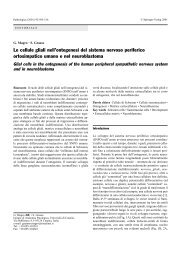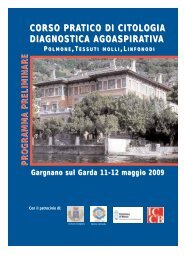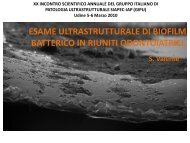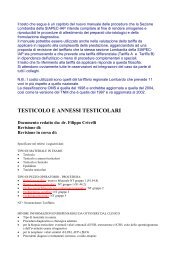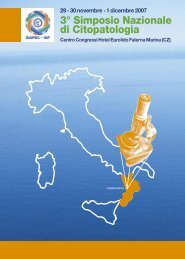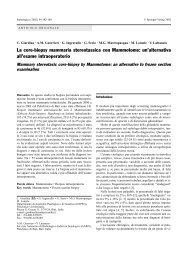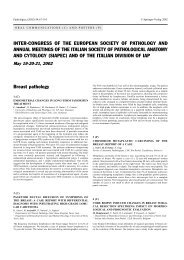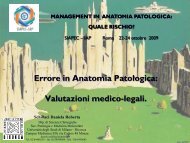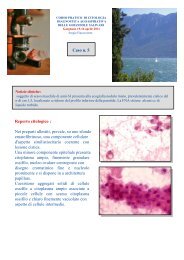Create successful ePaper yourself
Turn your PDF publications into a flip-book with our unique Google optimized e-Paper software.
382COMUNICAZIONI LIBEREpersistence for decades has also been demonstrated. Womenare disproportionately affected by autoimmune diseases,both systemic – e.g., multiple sclerosis, systemic lupus erythematosus,rheumatoid arthritis – and of single organs,such as liver and thyroid. Foetal cells have been found inthe skin lesions of systemic sclerosis patients and also polymorphiceruption of pregnancy has been reported to be associatedwith foetal microchimerism. Autoimmune diseasesof the thyroid occur in 8-10% of women in the postpartumperiod and may be transient or become chronic. The role offoetal microchimerism in the pathogenesis of Hashimoto’sthyroiditis and Graves disease has been investigated in asmall number of reports.AimThis study was aimed to assess the presence of foetal microchimerismin thyroid tissue affected by autoimmune diseasesby performing fluorescence in situ hybridisation(FISH) analysis on paraffin-embedded tissue sections. Thistechnique is an efficient method to detect the presence ofmale nuclei in female tissue.Materials and methodsThe files of the Department of Pathology of the Universityof Insubria were scanned to find all cases of Graves’ disease(GD) and Hashimoto’s autoimmune thyroiditis (HAT). Weselected 15 cases of GD and 4 cases of HAT. Medicalrecords including pregnancy histories, information aboutabortions and blood transfusions were reviewed for eachpatient. Negative controls were obtained from female under5 years who underwent tonsillectomy. All cases were previouslyscanned with a nested PCR for SRY gene. FISHanalysis was performed with alpha-satellite probes specificfor X and Y chromosomes. Interphasic FISH was done accordingto the protocol reported by Chin et al. (2003) withmodifications to improve the efficiency and the quality ofsignals in order to restrict artefacts of interphasic FISH onparaffin-embebbed tissues (Chin et al., 2003). Two or threeslides for each patient were scanned to detect the presenceof male cells (XY) among maternal cells (XX).ResultsTwelve of the 19 cases resulted positive at nested PCR,whereas all controls were negative. FISH analysis detectedcells with both an X and a Y chromosome signals in all casespositive with nested PCR. Microscopically, these cellswere seen as individual XY elements scattered among XXcells of thyroid tissue (1-14 per slide). Male cells were randomlydistributed within the thyroid follicles, and were notconcentrated within areas of lymphocytic infiltrates, suggestingthat they are fully differentiated male thyroid cells.ConclusionsThe thyroid of parous women affected by autoimmune diseasecontains male foetal cells, which are located in the thyroid follicles.FISH analysis is a useful tool to study microchimericcells. This approach allows to observe the topographic relationbetween maternal and foetal cells within the specimen and toquantify the number of the latter. Further investigation are requiredto better characterize these male cells.Two rare histological entities in the samethyroid gland: case reportG. Pennelli * , C. Mian ** , N. Pennelli * , N. Pavan *** , M.R.Pelizzo *** , F. Mantero ** , M.E. Girelli ** , M. Rugge **Department of Oncology and Surgical Sciences, Universityof Padova; ** Endocrinology Unit, Department of Medicaland Surgical Sciences, University of Padova; *** 3 rd Departmentof Surgery, University of Padova Medical SchoolA 63-year-old woman was admitted to the hospital for a largesoft swelling mass in the inferior part of the neck, associatedwith mild dyspnea. Physical examination revealed an enlargedright thyroid lobe. Laboratory findings disclosed suppressedthyrotropin levels with triiodothyronine and thyroxinewithin normal ranges. Ultrasonography showed multiple, partiallyconfluent nodes within the right lobe, coexisting withisthmic hypoechoic node (10 mm). An additional lesion, 70mm in diameter, was detected apart of the thyroid gland, featuringa sonographic pattern of lipoma. A subtotal thyroidectomywere performed together with the excision of the “lipomatous”nodule. The last one measured 70x55x35 mm andconsisted of a yellowish tissue demarcated by fibrous capsule.Histologically, it consisted of mature fat cells coexisting withsparse thyroid follicular structures. The thyroid origin of epithelialcells was established by TTF1 and Tg immunostaining.A diagnosis of adenolipoma was performed. The isthmicnode (9 mm in diameter) was encapsulated and displayed adiffuse macrofollicular growth pattern. The follicles werelined by large, cuboidal cells with clear nuclei with groovesand pseudo-inclusions. Neoplastic cells showed positive immunoreactionsfor TTF1, cytocheratin 19 and galectin-3; noimmunostaining for p53 was detected. The final diagnosiswas of papillary carcinoma, macrofollicular variant.Both, macrofollicular variant of papillary carcinoma and adenolipomaare extremely rare neoplasms. To our knowledge,this is the first report that describes the simultaneous presenceof these two rare entities in the same thyroid gland.





